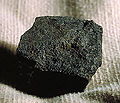Difference between revisions of "AY Honors/Coal/Answer Key"
(+ some answers) |
|||
| Line 7: | Line 7: | ||
</noinclude> | </noinclude> | ||
<!-- 1. What is coal? --> | <!-- 1. What is coal? --> | ||
| + | [[w:Coal|Coal]] is a combustible black or brownish-black sedimentary rock, formed as rock strata called coal seams. Coal is mostly carbon with variable amounts of other elements, chiefly hydrogen, sulfur, oxygen, and nitrogen. Coal is a type of fossil fuel, formed when dead plant matter decays into peat and is converted into coal by the heat and pressure of deep burial. | ||
<!--T:2--> | <!--T:2--> | ||
| Line 16: | Line 17: | ||
</noinclude> | </noinclude> | ||
<!-- 2. Read the flood story in Genesis 6-8 and relate the events as outlined in the story to how coal was formed. How does the Genesis flood account compare to other theories on the formation of coal and discuss in small groups assumptions that each theory needs to make and your opinion on the theories. --> | <!-- 2. Read the flood story in Genesis 6-8 and relate the events as outlined in the story to how coal was formed. How does the Genesis flood account compare to other theories on the formation of coal and discuss in small groups assumptions that each theory needs to make and your opinion on the theories. --> | ||
| + | You can read Genesis chapters 6-8 online at [https://www.biblegateway.com/passage/?search=Genesis+6-8&version=NKJV BibleGateway]. | ||
| + | |||
| + | {{#widget:YouTube|id=l935CKEKCaA}} | ||
<!--T:4--> | <!--T:4--> | ||
| Line 34: | Line 38: | ||
</noinclude> | </noinclude> | ||
<!-- 4. What is a BTU and a Joule and why are they important to the users of coal? --> | <!-- 4. What is a BTU and a Joule and why are they important to the users of coal? --> | ||
| + | [[w:British_thermal_unit|BTU]] stands for British thermal unit. The British thermal unit is a measure of heat, which is a form of energy. It was originally defined as the amount of heat required to raise the temperature of one pound of water by one degree Fahrenheit. | ||
| + | |||
| + | The [[w:Joule|joule]] is the unit of energy that is equal to the amount of work done when a force of one newton displaces a mass through a distance of one meter in the direction of that force. It is also the energy dissipated as heat when an electric current of one ampere passes through a resistance of one ohm for one second. | ||
<!--T:8--> | <!--T:8--> | ||
| Line 43: | Line 50: | ||
</noinclude> | </noinclude> | ||
<!-- 5. List three of the major uses of coal today and three major historic uses of coal. --> | <!-- 5. List three of the major uses of coal today and three major historic uses of coal. --> | ||
| + | Some of the major uses of coal today include: | ||
| + | * To generate electricity in power plants by thermal power generation (water to steam) | ||
| + | * In cement | ||
| + | * Paper production | ||
| + | * Ceramic manufacture | ||
| + | * Iron and steel production | ||
<!--T:10--> | <!--T:10--> | ||
| Line 96: | Line 109: | ||
</noinclude> | </noinclude> | ||
<!-- a. Lignite coal --> | <!-- a. Lignite coal --> | ||
| + | <gallery> | ||
| + | File:Mineral Lignito GDFL028.jpg | ||
| + | File:Pliocene Lignite Coal Serbia.jpg | ||
| + | File:Lignite Klingenberg.jpg | ||
| + | File:DBM Deutsches Bergbau-Museum Bochum, Lignit Westerwald.JPG | ||
| + | </gallery> | ||
<!--T:22--> | <!--T:22--> | ||
| Line 105: | Line 124: | ||
</noinclude> | </noinclude> | ||
<!-- b. Anthracite coal --> | <!-- b. Anthracite coal --> | ||
| + | <gallery> | ||
| + | File:Anthracite Coal.JPG | ||
| + | File:Anthracite chunk.JPG | ||
| + | File:Anthracite (coal).jpg | ||
| + | File:Ibbenbueren Anthracite.JPG | ||
| + | </gallery> | ||
<!--T:24--> | <!--T:24--> | ||
| Line 114: | Line 139: | ||
</noinclude> | </noinclude> | ||
<!-- c. Subbituminous coal --> | <!-- c. Subbituminous coal --> | ||
| + | <gallery> | ||
| + | File:SUB-BITUMINOUS COAL LIKE THE PIECE JOHN REDDING IS HOLDING LIES UNDER THE SURFACE OF SOME 25,000 SQUARE MILES OF... - NARA - 549121.jpg | ||
| + | </gallery> | ||
<!--T:26--> | <!--T:26--> | ||
| Line 123: | Line 151: | ||
</noinclude> | </noinclude> | ||
<!-- d. Bituminous coal --> | <!-- d. Bituminous coal --> | ||
| + | <gallery> | ||
| + | File:Coal bituminous.jpg | ||
| + | File:Bituminous Coal.JPG | ||
| + | File:Bituminous coal (Upper Freeport Coal, Middle Pennsylvanian; Diamond Coal Mine, Linton, Ohio, USA) 7.jpg | ||
| + | File:Bituminous coal label.JPG | ||
| + | </gallery> | ||
<!--T:28--> | <!--T:28--> | ||
| Line 133: | Line 167: | ||
</noinclude> | </noinclude> | ||
<!-- 11. Know the characteristics of each of the four main types of coal, including: percentage of carbon; color range and appearance features; primary uses; BTU (kJ) content; areas where mined; and other facts of interest. --> | <!-- 11. Know the characteristics of each of the four main types of coal, including: percentage of carbon; color range and appearance features; primary uses; BTU (kJ) content; areas where mined; and other facts of interest. --> | ||
| + | ==Lignite coal== | ||
| + | [[w:Lignite|Lignite]] has between 25-35% carbon. It is also known as brown coal. It has the less percentage of carbon and the lowest BTU value with up to 70% water. It is used mainly for electrical generation power plants. | ||
| + | |||
| + | ==Anthracite coal== | ||
| + | [[w:Anthracite|Anthracite]] coal has the highest percentage of carbon (86-98%) with the lowest volatile matter. It is a hard and brittle coal with a black lustrous look. It produces around 13,000 – 15,000 BTU’s. It is used to make coke, which is used for steel making. | ||
| + | |||
| + | ==Subbituminous coal== | ||
| + | [[w:Sub-bituminous_coal|Subbituminous coal]] has between 35 -45% carbon. It has a soft dull (lighter) black appearance. It produces around 8,500–13,000 BTU’s. Its low-to-moderate heating values is mainly used for electrical generation power plants. | ||
| + | |||
| + | ==Bituminous coal== | ||
| + | [[w:Bituminous_coal|Bituminous coal]] has between 45-85% carbon. It is blocky in appearance with alternating layers of dull and shiny layers. Its BTU range is between 11,000-15,000. It is used for both steel making and electrical generation power plants. | ||
<!--T:30--> | <!--T:30--> | ||
| Line 223: | Line 268: | ||
</noinclude> | </noinclude> | ||
<!-- 14. Memorize Romans 8:28. Discuss how bad events in your life, or of someone you know, has provided fuel for better things, in much the same way that the flood in Genesis created coal. --> | <!-- 14. Memorize Romans 8:28. Discuss how bad events in your life, or of someone you know, has provided fuel for better things, in much the same way that the flood in Genesis created coal. --> | ||
| + | |||
| + | {{Bible verse | ||
| + | |book = Romans | ||
| + | |chapter=8 | ||
| + | |verse=28 | ||
| + | |version = NKJV | ||
| + | |text = And we know that all things work together for good to those who love God, to those who are the called according to His purpose. | ||
| + | }} | ||
<!--T:50--> | <!--T:50--> | ||
Latest revision as of 14:38, 8 April 2024
1
Coal is a combustible black or brownish-black sedimentary rock, formed as rock strata called coal seams. Coal is mostly carbon with variable amounts of other elements, chiefly hydrogen, sulfur, oxygen, and nitrogen. Coal is a type of fossil fuel, formed when dead plant matter decays into peat and is converted into coal by the heat and pressure of deep burial.
2
3
4
BTU stands for British thermal unit. The British thermal unit is a measure of heat, which is a form of energy. It was originally defined as the amount of heat required to raise the temperature of one pound of water by one degree Fahrenheit.
The joule is the unit of energy that is equal to the amount of work done when a force of one newton displaces a mass through a distance of one meter in the direction of that force. It is also the energy dissipated as heat when an electric current of one ampere passes through a resistance of one ohm for one second.
5
Some of the major uses of coal today include:
- To generate electricity in power plants by thermal power generation (water to steam)
- In cement
- Paper production
- Ceramic manufacture
- Iron and steel production
6
7
8
9
10
11
Lignite coal
Lignite has between 25-35% carbon. It is also known as brown coal. It has the less percentage of carbon and the lowest BTU value with up to 70% water. It is used mainly for electrical generation power plants.
Anthracite coal
Anthracite coal has the highest percentage of carbon (86-98%) with the lowest volatile matter. It is a hard and brittle coal with a black lustrous look. It produces around 13,000 – 15,000 BTU’s. It is used to make coke, which is used for steel making.
Subbituminous coal
Subbituminous coal has between 35 -45% carbon. It has a soft dull (lighter) black appearance. It produces around 8,500–13,000 BTU’s. Its low-to-moderate heating values is mainly used for electrical generation power plants.
Bituminous coal
Bituminous coal has between 45-85% carbon. It is blocky in appearance with alternating layers of dull and shiny layers. Its BTU range is between 11,000-15,000. It is used for both steel making and electrical generation power plants.
12
12a
12b
12c
12d
13
13a
13b
13c
14
And we know that all things work together for good to those who love God, to those who are the called according to His purpose.















